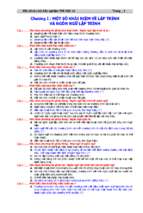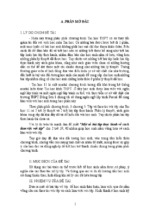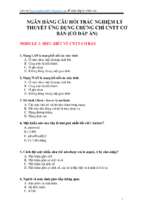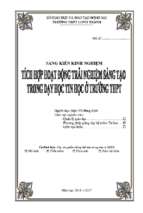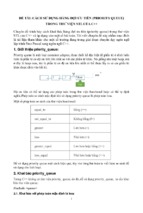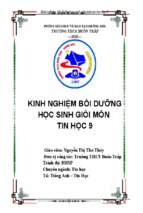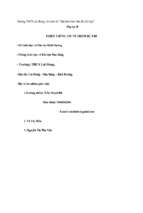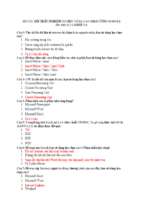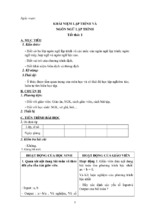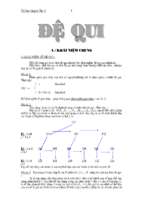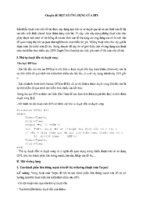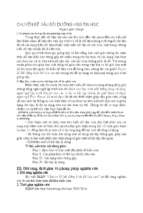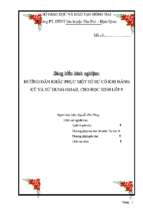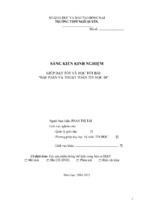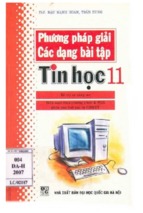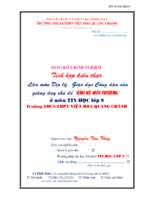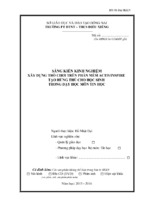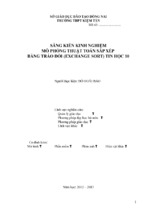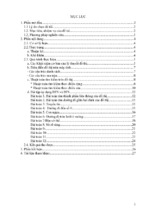Mô tả:
Bài giảng Tin học đại cương A (dành cho khối tự nhiên): The component base of C.language
The component base of C
language
Nguyễn Dũng
Faculty of IT – Hue College of Science
Content
A brief history of C
Standard of C
Characteristics of C
The C compilation model
Character set and keyword
Data types
Comment, variable, constant
Structure of program
Expression and operators
2
A brief history of C
The C programming language is designed and developed by
Dennis Ritchie at Bell Laboratories in the early 1970s.
Evolved from B (Ken Thompson, 1970), which evolved from
BCPL (Martin Richard, 1967).
Designed for systems programming
Operating system
Compiler
Utility program
…
It is also widely used for
developing application software
3
Standard of C
Be Standardized in 1989 by ANSI (American National
Standards Institute) known as ANSI C
In 1990, the ANSI C standard was adopted by the International
Organization for Standardization (ISO) is known as C89
As part of the normal evolution process the standard was
updated in 1995 (C95) and 1999 (C99),…
4
Characteristics of C
Program written in C are very efficent, fast and small in size.
Structered language. Extensive use of functions
C is a powerful and flexible language. It can be used for
projects as Operating System, Word Processors, Graphics,…
and even compilers for another language.
C is highly portable language. This means that a C program
written for one computer system can be run on another
computer system with a little or no modification.
…
5
The C compilation model
The preprocessor accepts source code as input and
removes comments
extends the code according to
the preprocessor directives
included in the source code
The compiler takes output of preprocessor
and produces assembly code
The assembler takes the assembly code and
produces machine code (or object code)
The linker takes the object code, joins it
with other object code and libraries and
produces code that can be excutable.
6
Character set and keywords
Character set of C language includes the following characters:
Letters: a - z, A – Z, _
Digits: 0 – 9
Punctuation: ~ ! @ # % ^ & * ( ) - + = : ;
" ' < > , . ? | / \ { } [ ]
Keywords:
double
int
struct
break
else
long
switch
case
enum
register
typedef
char
extern
return
union
const
float
short
unsigned
continue
for
signed
void
default
goto
sizeof
volatile
do
7
auto
if
static
while
Rules of Name
Name in the C language is a set of characters which:
can contain numbers, letters and
underscore
must be started with letters or underscore
can not contain special characters or
space
isn„t similar keyword
is case sensitive
Example:
“Percent, y2x5__fg7h, _1990_tax, A” are
right
“ngay-sinh, double, 9winter” are wrong
8
Comments
There are two types of comment:
comment on single line:
comment on multi line
9
Syntax: //
Example: //this is a comment line
Syntax: /* */
Example:
/*
This is first comment line
…
This is n(th) comment line
*/
Structure of a C program
A C program contains the following elements:
Proprocessor command
Type definitions
Function prototypes
Variables and constants
Functions
All programs must contain a single “main” function. All functions,
include “main” function, have the following formating:
type_return function_name(parameters)
{
//Body function
}
10
Structure of a C program (cont)
Example
#include
#define TIMES 10
double myfunction(float);
void main() {
double wert;
double pi = 3.14;
printf(“Multiply by 10\n”);
wert = myfunction(pi);
printf(“%d * %f = %f\n”,TIMES, pi, wert);
}
double myfunction(double zahl){
int i;
double count = 0;
count = TIMES * zahl;
return count;
}
11
Data types
Type
Size
(byte)
The sizes of the data
types types are not
standardized (depend
on the implementation
Range
system and compiler)
unsigned char
1
0255
[signed] char
1
-128127
usigned int
2
065535
[signed] int
2
-3276832767
unsigned short int
2
065535
[signed] short int
2
-3276832767
unsigned long
4
04.294.967.295
[signed long]
4
-2.147.483.6482.147.483.647
float
4
3.4E-383.4E+38
double
8
1.7E-3081.7E+308
long double
10
3.4E-4931.1E+4932
C has the following basic data
12
Constant
A constant specifies a value that cannot be modified by a
program
Special constants for use with strings
\n
\t
\r
\b
\”
\0
13
newline
tabulator
carriage return
backspace
escape double quote
end string
Constant (cont)
preprocessor
Syntax
#define
Case 1:
Example:
const
= ;
Case 2:
Example:
14
#define PI 3.14
const float PI = 3.14;
Variable
A variable specifies a area of memory that contains a value of a
given type that can be modified by a program
sizeof() is a function that returns the size of a given variable in
bytes (the size depends on the type of the variable)
Variables should be initialized before they are used (e.g., in the
declaration) otherwise the variables contain a random value (or
default value depends on compiler)
15
Variable (cont)
Syntax:
name_var
[=init_value];
Example:
int y=5;
unsigned int z;
16
Operators
+, -, *, /, %
Relational comparisons: >, >=, <, <=, ==, !=
Logical operators:
Assignment:
Increment and decrement:
Conditional evaluation:
Arithmetic:
&& (and), | (or), ! (not)
=
a = (5 > 2) ? 10 : 5;
17
++, --
?:
a = ???
Bit - Operators
Include: & (and), | (or), ^ (xor), ~ (not), << (shift left), >> (shift
right)
And bit:
char a = 10;
0
0
0
0
1
0
1
0
0
0
0
0
1
1
0
0
0
0
0
1
0
0
0
char b = 12;
char c = a & b;
0
18
Bit - Operators
Shift bit:
char a = 10;
0
0
0
0
1
0
1
0
a << 2;
0
0
0
1
0
1
0
0
a = 10 * 22= 40
0
19
0
1
0
1
0
0
0
Priority of operators
20
- Xem thêm -

